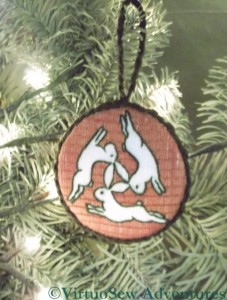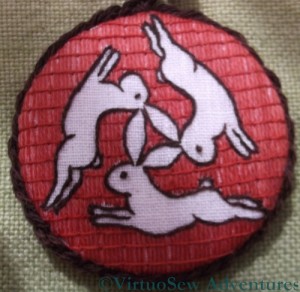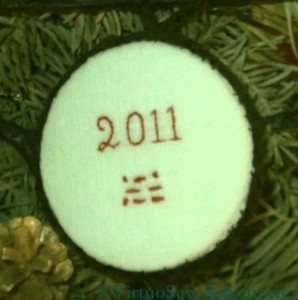Another variation on the Three Hares
When I wrote about the Three Hares design I created for Handmade Living magazine, I mentioned that I was rather taken with the design as a framework for experimentation. I have an idea in my head for quite a big project based on the design, but while that’s simmering away and developing in my head, I have gone in the other direction.
This is a much smaller and much more complex version, but maintaining the historical connection, I chose to use Bayeux Stitch (there is a diagram in this Embroiderer’s Guild pdf) for the background. The stitching uses fine woollen threads on a linen ground, and naturally I followed my usual habit of increasing the complexity of my adventures in stitchery.
Bayeux Stitch is worked in two phases, of which the first is surface satin stitch. I chose to alternate two shades of rust for the surface satin stitch, and then the couching stitches went over the top using the darker shade. It doesn’t really show in the photographs, which were taken in rather dismal lighting conditions, but it does show in real life, and it makes the background shimmer slightly – which is a good trick when there’s no metallic thread involved!
Whereas in the first variant, created for Handmade Living magazine, I simply outlined the design, gaining all of the interest from the contrast of fabric and thread, in this case I outlined the motif (in back stitch), then covered the background completely with stitching.
Finally, I turned the embroidery into a hanging decoration by the same method used for the Glittering Snail, but before I covered the back with fabric, I added the year and then my initials in Morse Code.




The Bayeux stitch is really effective, Rachel. Wishing you all the happiness of the season; see you next year.
Interesting stitch ,lovely background ! Looks like Assisi embroidery minus all the cross stitches.
Love this! You are so talented and creative to make each piece as detailed as you do. Your use of stitch is marvelous. This is the perfect way to save a piece of your own work from year to year. I like the idea of using morse code for your initials. I’m thinking of creating mine in Braile – much easier than trying to stitch a whole signature onto the back of a piece.
Oh, that’s one beautiful ornament, Rachel. Your knowledge of historical stitchings is very impressive. I love the Bayeux stitch and am looking to interpret it in some way…but not traditionally!
Seasons blessings on you and yours.
Wot Penny said in her first comment. 🙂
I love the ornament and as I bought a couple of embroideries whilst in Bayeux thanks for the link to the PDF. ( My French is not that good.)
Have a Merry Xmas.
Lovely even Bayeux stitch and the hares are beautifully detailed. I’m very fond of this particular image and it’s lovely to see it so skilfully executed.
Beautiful, Rachel!